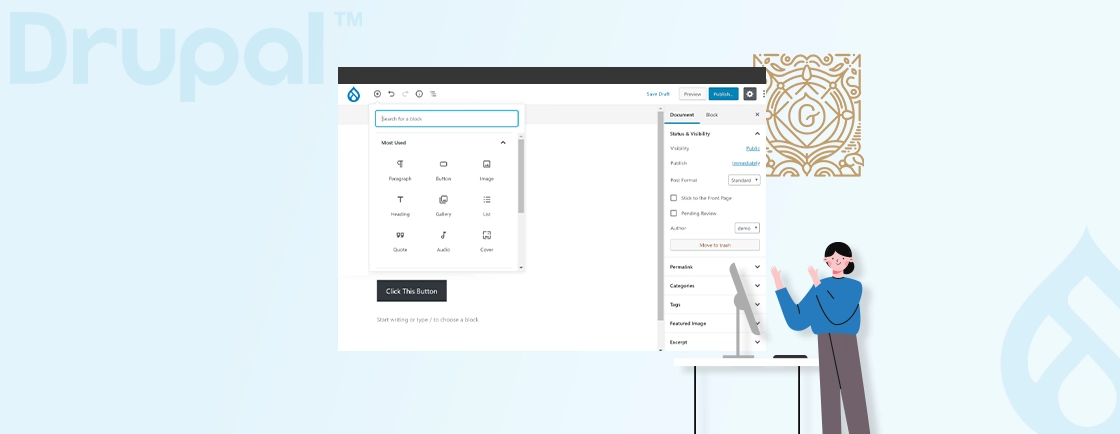Table of Contents
Creating efficient and maintainable templates in Drupal can often feel complex. Developers frequently encounter repetitive coding patterns and limitations with the default Twig functionality. These problems not only slow down development but also lead to cluttered, hard-to-maintain codebases. For large-scale projects, the inefficiency compounds over time.
So, what’s the solution? Using the Drupal Twig Tweak module. It is designed to enhance the native capabilities of Twig in Drupal. By streamlining syntax and simplifying debugging Twig Tweak makes the theming process simple.
In this blog, we’ll dive into the key features and benefits of using Twig Tweak module. We’ll help you learn how to install the Twig Tweak module and the best practices followed by Drupal development experts for using it. With that said, let’s get started!
What is Twig Tweak in Drupal?
Twig Tweak is a powerful Drupal module designed to extend the native functionality of Twig, the theming engine used by Drupal. By introducing a suite of additional filters, functions, and tags, Twig Tweak empowers developers to streamline template creation and theming workflows.
Key Features of Twig Tweak:
- Simplified Syntax: It replaces verbose and repetitive coding patterns with intuitive and concise syntax. For instance, rendering a block or embedding a view becomes a one-liner operation, saving time and reducing errors.
- Enhanced Debugging Tools: Developers gain access to robust debugging utilities, such as the ability to inspect complex data structures within templates. The dump() function, for example, allows you to effortlessly visualize variable contents and their hierarchical relationships.
- Extended Twig Capabilities: Twig Tweak introduces new capabilities that go beyond the standard Twig features. This includes functions for rendering entities, generating URLs, accessing configuration values, and embedding views or blocks directly into templates.
By reducing boilerplate code and providing seamless access to Drupal’s structured data, Twig Tweak allows developers to focus on crafting elegant, maintainable, and high-performing frontend solutions. It is particularly valuable in large-scale projects where efficiency and clarity are critical.
How to Install Drupal Twig Tweak?
To integrate Twig Tweak into your Drupal project, follow these simple steps:
Step 1: Install the Module
Use Composer to install the Twig Tweak module. This will add the module to your project and make its functions available for use.
composer require drupal/twig_tweak
Step 2: Enable the Module
After installation, enable the module. You can do this via the admin interface or use Drush for a quicker approach.
drush en twig_tweak -y
Step 3: Clear the Cache
Finally, clear the site cache to ensure the new module is properly integrated and its Twig functions are available for use.
drush cr
By following these steps, you will be able to use Twig Tweak’s templating features in your Drupal project.
If you are finding it complex to build a custom-designed website, get in touch with our Drupal development company.
Key Features and Examples of Twig Tweak
Twig Tweak provides a set of powerful tools to enhance your templating experience in Drupal. Below are some of the key features, along with examples of how to use them effectively:
Rendering Entities
With Twig Tweak, you can easily render entities, such as nodes, directly within your templates using the drupal_entity() function. This allows you to render the full content of any entity by simply specifying its type and ID.
Example: {{ drupal_entity(‘node’, 1) }}
This code will render the entire content of the node with ID 1.
Embedding Views
Twig Tweak simplifies embedding Drupal views into your templates. You can specify the view machine name and the display settings, such as blocks or page displays.
Example: {{ drupal_view(‘view_machine_name’, ‘block_1’) }}
This renders the view named view_machine_name with the display block_1 directly within the template.
Accessing Configuration
Fetching site configuration directly from your templates is easy with Twig Tweak. You can access system configurations like the site name, or any other available configuration.
Example: {{ config(‘system.site’).name }}
This retrieves and displays the site’s name from the system configuration, making it simple to pull configuration settings into your templates.
Debugging Made Easy
Twig Tweak provides a convenient dump() function to help you debug your templates by inspecting variables and data structures. It’s a quick way to visualize data during development.
Example: {{ dump(content) }}
This outputs the content variable, allowing you to inspect its structure and contents in the template.
Rendering Blocks
With Twig Tweak, embedding blocks directly into templates is straightforward. The drupal_block() function allows you to render any block by specifying its machine name.
Example: {{ drupal_block(‘block_machine_name’) }}
This renders the block identified by block_machine_name, allowing for easy integration of blocks within your template. Beyond standard entity rendering, Twig Tweak modules enable Drupal Font Awesome icons in templates with the drupal_block() function. It helps in icon field rendering for enhanced visual elements.
String and Path Manipulation
Twig Tweak also offers helper functions for manipulating strings and paths. For example, generating URLs for files can be done using the file_url() function.
Example: {{ file_url(‘public://example.jpg’) }}
This generates the full URL for a public file, which can then be used for image or file links within your template.
These features of Twig Tweak make it easier to interact with Drupal’s core directly within templates. It improves both development speed and flexibility.
Why Use Drupal Twig Tweak?
Twig Tweak is a game-changer for developers looking to enhance their efficiency and maintain cleaner codebases. It bridges the gap between complex backend logic and frontend presentation by providing tools that simplify and accelerate the theming process. Here’s how Twig Tweak stands out:
Simplifies Template Code
Traditional Drupal theming often involves repetitive PHP logic, which can clutter templates and make maintenance challenging. Twig Tweak replaces these patterns with concise and expressive Twig expressions. For example, tasks like embedding a block or rendering a node require minimal code, making your templates more readable and easier to manage.
Speeds Up Development
With Twig Tweak, routine tasks such as rendering blocks, entities, or views become simple and fast. By eliminating the need to write boilerplate code into backend configurations, developers can focus on delivering features more efficiently. Twig Tweak is valuable when working on performance-critical implementations such as the Drupal AMP module. Here, clean, efficient template code ensures AMP compliance while maintaining dynamic content rendering. Whether you’re creating a complex layout or theming a single page, Twig Tweak accelerates the workflow and reduces development effort.
Improves Debugging
Debugging template data is often a time-consuming process. Twig Tweak addresses this by providing robust debugging tools that give deeper insights into the data structures available within your templates. With functions like dump(), developers can quickly inspect variables and their contents, facilitating faster issue resolution and better template accuracy.
These benefits of using Twig Tweak empowers developers to deliver customized theming solutions with less effort. Now, let’s dive into some of the best practices you can follow when using Twig Tweak.
Best Practices for Using Twig Tweak
To make the most of Twig Tweak in your Drupal templates, it’s important to follow a few best practices. These will help keep your templates clean, efficient, and maintainable.
Avoid Overusing dump()
The dump() function is an invaluable debugging tool, but overusing it can clutter your templates and negatively impact performance. It’s important to remove or comment out dump() calls in production environments to avoid unnecessary output. Use dump() only when debugging specific variables or data structures.
Keep Logic Minimal
Twig templates should focus primarily on rendering content rather than handling complex logic. It’s best to avoid embedding extensive business logic within your templates, as this can make your templates harder to read and maintain. Instead, keep templates simple by moving complex logic to preprocess functions or custom modules, leaving the templates to handle presentation.
Comment Your Code
Good documentation is key to maintaining and evolving your templates. When using custom Twig Tweak functions or implementing complex logic, make sure to add clear comments explaining what the code does. This is especially helpful for team collaboration or when you need to revisit your code months or years later.
Example:
{# Render the node with ID 1, this will display the full content of the node #}
{{ drupal_entity('node', 1) }}
This helps other developers (or even your future self) understand the intent behind the code.
Use Drupal’s Cache
Twig Tweak integrates seamlessly with Drupal’s caching system. This means that templates can benefit from Drupal’s caching mechanisms to improve performance. However, when making changes to templates or adding new functionality, always ensure that you clear the cache to see the effects of your updates. Failure to clear the cache can result in outdated content or template issues that are difficult to diagnose.
To clear the cache, you can use the following Drush command:
drush cr
This will ensure that your changes are applied, and Drupal caches the updated templates. For developers learning how to use Drupal Bootstrap with webforms, Twig Tweak complements form theming by providing direct access to form elements and blocks within Bootstrap-based templates, streamlining the integration of responsive form layouts.
By following these best practices, you can ensure your templates are efficient, maintainable, and easy to work with. If you are looking to make advanced use of the Twig Tweak module, jump to the next section.
Advanced Use Cases for Twig Tweak
Twig Tweak enables dynamic and flexible templating. Below are two advanced use cases of Twig Tweak.
Building Dynamic Layouts
Twig Tweak allows you to load components dynamically based on contextual data, making your layouts more flexible. For example, you can conditionally display blocks depending on the node type:
{% if node.type == 'article' %}
{{ drupal_block('article_teaser') }}
{% endif %}
In this case, the article_teaser block is rendered only for nodes of type article, enabling context-sensitive layouts. When implementing Drupal A/B testing for template variations, Twig Tweak simplifies rendering different content blocks or views based on test parameters.
Using Twig Extensions
You can extend Twig templates with custom PHP functions by integrating Twig Tweak with custom modules. This lets you introduce complex logic or data manipulation directly within your templates. After defining custom functions in your module, you can call them like any other Twig function:
{{ custom_function(variable) }}
This integration allows for seamless inclusion of custom logic in your templates while keeping the structure clean and efficient.
Wrapping Up
Twig Tweak enhances Drupal theming by introducing intuitive tools that simplify rendering, debugging, and data integration in templates. Its concise syntax replaces repetitive code, while features like entity rendering and view embedding streamline workflows.
By following the best practices such as minimizing logic in templates,using Drupal’s cache, and more, you can maintain efficient and readable code. Advanced capabilities like dynamic layouts and custom Twig extensions further expand its utility, making it ideal for creating custom and scalable solutions.
If you are looking to build a well-designed and robust website, hire Drupal developers.
FAQs About Drupal Twig Tweak
Can Twig Tweak be used to debug templates?
Yes, Twig Tweak offers the dump() function, allowing you to inspect variables and their structures directly within templates. This makes debugging faster and more intuitive during development.
What is the benefit of using Twig Tweak over custom PHP functions?
Twig Tweak simplifies template logic by providing predefined Twig functions, reducing the need for complex PHP code and improving maintainability.
Is Twig Tweak suitable for large-scale Drupal projects?
Absolutely. Twig Tweak is especially valuable for large-scale projects, as it reduces development time, simplifies theming workflows, and ensures maintainable code for complex layouts.
Unleash the Potential of Drupal
Access expert guides and insights to leverage Drupal for scalable and secure web solutions.





